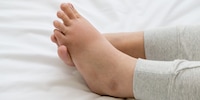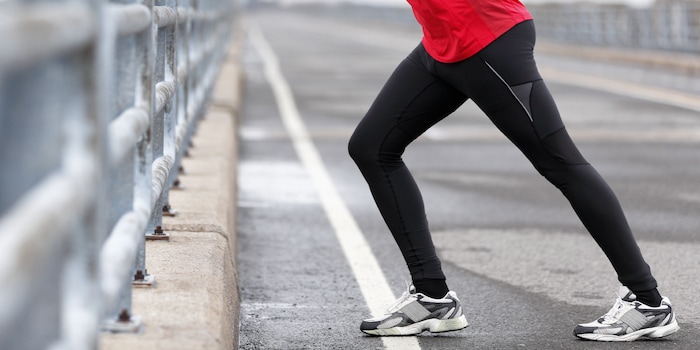
Background information
How to combat swollen legs
by Mareike Steger

You’ve just run or swum the first few metres. But instead of feeling energised, you feel your calf spasm, forcing you to take a breather. Leg cramps can even surprise you in your sleep. What can you do against them?
Leg cramps are a nasty beast. They come on suddenly and attack hard. Your muscle tightening unexpectedly can be extremely painful. What can you do to fight it? Is your only option to take the weight off your leg and stretch it until the spasm passes, which can take up to several minutes? Well, yes and no.
There are also ways to prevent cramps from happening in the first place. The culprit behind them is often acidosis in the muscles. According to the Ruhr University Bochum (in German), in a hyperacidic environment, the muscles have too little oxygen available and anaerobic metabolic processes (i.e. not requiring oxygen) kick in to generate the required energy. The by-product of these anaerobic processes is lactate, or lactic acid. The body can break down the lactate to a certain extent. But eventually, its stores are full and the impending cramp gets closer and closer (although, NB, too much lactate alone won’t lead to a cramp).
Another cause of leg cramps can be dehydration. This especially affects older people, who often drink too little for fear of having to go to the toilet at night.
In other words, causes for a cramp can include a lack of fluids and/or oxygen as a result of intense training. To prevent this, there are a few significant things you can do.
Stay hydrated
Drink enough before, during and after sport. Start about two hours before your workout to avoid feeling full and to have time to pee it out, all while staying well hydrated. But do keep in mind that it’s also possible to drink too much water. Other benefits of staying hydrated include better blood supply to your body, better temperature regulation (because more sweat can evaporate) and the improved ability to concentrate and focus.
Warm up well
To ensure your muscles are well supplied with blood – and therefore oxygen and nutrients – you should start your workout slowly. More on this under recommendation #4, stretching.
Replenish your electrolytes
Magnesium, sodium and potassium are important building blocks for smooth muscle function. They play a crucial role in maintaining the body’s fluid and pH balance as well as muscle and nerve function, helping you stay hydrated and consequently avoiding cramps. Natural sources of these minerals include coconut water, bananas, orange juice and yogurt.
Stretch
Stretch before and after exercise, as well as before going to bed if you’re prone to night cramps. According to a report by the Cleveland Clinic in the USA, up to 60 per cent of adults suffer from nighttime leg cramps. Dynamic stretching exercises are recommended before exercise to activate the muscles and stimulate blood circulation, which aids in preventing injuries, strains and cramps. After exercise, static stretching exercises, where you hold certain positions for longer, are recommended, helping to relax and lengthen the muscles.
The risk of cramps rises during pregnancy. According to Harvard Health Publishing, one possible reason for this is «circulatory changes and increased stress on the muscles from a growing belly».
As previously mentioned, the risk of cramps also increases with age, mainly due to a lacking water intake as well as the fact that older muscles tire more quickly than young ones. The publication also states that another significant risk factor for cramps is certain types of medicines, for example for the treatment of high blood pressure, high cholesterol or diabetes.
If you do get a leg cramp, try to remain calm (I know it’s tough!) and sit or lie down immediately to take the load off your leg. Light stretching can also help to loosen up the muscle – emphasis on «light».
Stretch
Stand with the affected leg slightly bent and point your toes up towards your body until you feel a stretch in the calf muscles. Hold this position for about 15 to 30 seconds and repeat this several times until the cramp subsides.
Massage
A massage can also alleviate the pain. Gently massage the affected muscles to promote blood circulation and relieve muscle tension. Circular movements are particularly effective. Just be sure to increase the pressure slowly to avoid pain.
Apply heat
Heat is a tried and tested remedy for all kinds of cramps. A hot water bottle doesn’t just come in clutch for stomach pain, but can also provide relief for leg cramps. A warm towel, warm compress, heat patch or warming (horse) ointment can also help to relax the muscles and relieve the cramp. Apply the heat source to the affected area and hold it there until the cramp subsides.
No one’s safe from cramps; they can occur at any time and without warning. But if you regularly suffer from calf cramps that last several minutes despite staying hydrated and keeping your electrolytes in balance, you should consider seeing a doctor – especially if you also have symptoms such as numbness or swelling. Then it’s important not to waste any time; cramps can also be a symptom of pre-existing conditions such as diabetes, kidney problems, circulatory disorders, nerve damage and other neurological diseases.
Notebook, camera, laptop or smartphone. For me, life's about taking notes – both analogue and digital. What's always on me? My iPod Shuffle. It's all in the mix, after all. This is also reflected in the topics I write about.
Interesting facts about products, behind-the-scenes looks at manufacturers and deep-dives on interesting people.
Show all